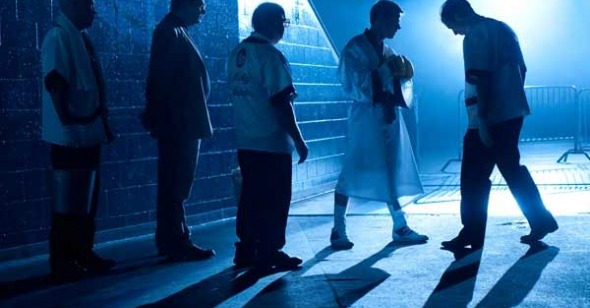Don’t Call It a Comeback
by Elbert Ventura
The Fighter
Dir. David O. Russell, U.S., Paramount Pictures
David O. Russell’s The Fighter is a boxing movie about second chances and unlikely redemptions—not least the director’s. It’s been six years since Russell last had a movie in theaters, and the hiatus has not been kind to his reputation. His last movie, I Heart Huckabees, flopped, his tantrums on that set became the stuff of YouTube legend, and another project, Nailed, was aborted after Russell clashed with his actors and the funding stopped. Too smart for the multiplex, and too wild for Hollywood? It figures that Russell would make his return with a film blanched of idiosyncrasy.
The least interesting movie of Russell’s interesting career, The Fighter was someone else’s passion project. Mark Wahlberg nursed the story of Lowell, Massachusetts, boxing legend Micky Ward for years, even training with the real life Ward and his half-brother Dickie Eklund in preparation for the role. In the early Nineties, Ward was a boxer on the slow track to becoming a stepping stone—the kind of fighter promoters sign as sacrificial lambs for true contenders. His brother Dickie had been a Lowell boxing hero in his day, even knocking down Sugar Ray Leonard (or so he insists—the tape is ambiguous) in a 1978 bout. Dickie devoted his post-fight career to training his brother for the shot he never had.
The Fighter opens on Micky (Wahlberg) and Dickie (Christian Bale) working on a road crew and being followed by a couple of filmmakers making a movie about Dickie’s life. A chronicle of a comeback? The documentary they’re making would go on to air on HBO, titled High on Crack Street: Lost Lives in Lowell. But Dickie’s crack addiction is only one of the mines littering Micky’s life. Back home, there are eight more: an overbearing mother (Melissa Leo) who manages his career (poorly) and seven sisters, uncharitably depicted here as slack-jawed Gorgons. A losing streak, punctuated by his brother’s repeated failures to show up for his training, ultimately forces Micky to look outside the family to advance his career.
It turns out to be a good decision. With the dead weight cut loose, Micky enjoys a rapid rise, plowing through a succession of palookas and up-and-comers. His girlfriend, Charlene (Amy Adams), keeps him insulated from the coven at home, while Dickie has to watch it all from behind bars, after he and his crackhead friends are busted impersonating police officers and robbing set-up tricks. The stage is set for an emotional confrontation. Upon Dickie’s release, will Micky reunite with his beloved brother or keep his new training team? Will everyone put aside their differences to help Micky succeed? Will Micky win the title despite being an underdog? Is this really all there is?
Russell may have sublimated his sensibilities, but his movie is hardly diffident. The Fighter bustles with ostentatious displays of local color and scenery chewing. Bale, Leo, and Adams take turns commandeering the camera with showboat performances. Though these actors’ turns are not without their pleasures, there’s also something fundamentally hollow about them—an allergy to quiet, a tendency toward pandering. (Bale comes out looking the best, but even his engaging turn is diminished by the chintzy frame that holds it.) Wahlberg, for his part, is restrained—and deadly dull. His Micky is embalmed in a hagiographic sheen; he’s so decent and dignified one wonders whether he’s actually related to the brood of sea cows at home.
Boxing might be a tempting subject, but it was the tussles outside the ring that drew Russell’s attention. He offered his notes while Wahlberg developed the project, but grew interested in directing as the process went on. “I started to look at the material, at who the people were, and that’s what made me interested—the seven bleached-blond sisters, the bleached-blond mother, this crazy family dynamic,” he told an interviewer. It’s a revelatory quote. Working from material based on real lives, Russell honed in on the comic possibilities of caricature. At its worst, the movie traffics in Jerry Springer trashiness. The sisters’ dumbness and ugliness are played for laughs (one wonders what the family thinks of how Micky and Dickie’s Hollywood friends portrayed them in a movie that’ll be seen by millions). It’s saying something that the most entertaining standoff in a boxing flick is a catfight between the foul-mouthed Charlene and one of the sisters.
Considering its outsized characters and conflict-ridden scenario, The Fighter is remarkably tension-free. Russell is careful not to trouble our placid expectation of a feel-good outcome. Eternal grudges are settled in a snap. Disputes fade away as the climactic fight nears. It hardly ruins anything to tell the reader that the movie ends in triumph for our protagonist—you all but expect it from a Hollywood boxing movie not named Raging Bull. But the failure to complicate its sainted hero, or to challenge the audience in any way, makes this a pretty blunt instrument.
Russell’s move and movie parallel those of another indie star: Darren Aronofsky. After The Fountain was laughed out of theaters, Aronofsky went on an aesthetic austerity plan and slummed his way to respectability with the hugely overrated The Wrestler. (This grade inflation of Aronofsky is becoming a habit for critics, if Black Swan’s reviews are anything to go by.) The Fighter is no less concerned with building back a director’s rep, though it does miss The Wrestler’s fascinating sports ethnography. (Russell and company have precious little to teach us about boxing.) Perhaps it’s no coincidence that Aronofsky was once connected with the project, or that his name now appears in its credits as an executive producer. Calculated and insincere, The Fighter couldn’t have asked for a more fitting imprimatur.
